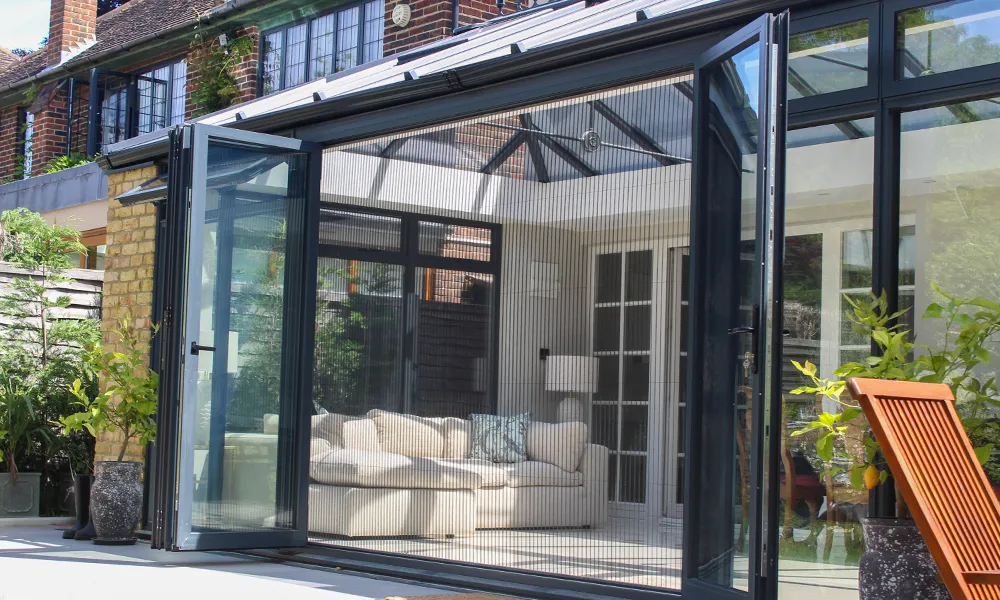Modern architects face the eternal challenge of merging beauty with practicality in their designs. Where conventional solutions fall short, retractable fly screens emerge as a game-changer – offering invisible protection that preserves clean sightlines when not in use.
These innovative systems have become essential for projects emphasizing fluid transitions between interior and exterior spaces. Leading manufacturers have refined the technology to near-perfection, with mechanisms that tuck discreetly into door frames.
Unlike bulky traditional options that interrupt architectural harmony, today’s advanced solutions maintain aesthetic integrity while delivering full functionality. The evolution from obvious barriers to disappearing systems redefines what is possible with modern fly screens for doors.
Types of Fly Screens for Doors
Selecting the perfect fly screen involves understanding three main options. Professionally installed screens offer expert fitting for flawless results. DIY kits provide budget-friendly solutions for handy homeowners. Made-to-measure screens deliver custom sizing with self-installation flexibility.
Each option caters to different needs, ensuring every home can enjoy insect-free comfort while matching specific preferences and budgets.
Why Architects Love Retractable Screens
1. Uninterrupted Views
- Preserve sightlines to landscapes and cityscapes
- Maintain clean architectural lines when retracted
- Enable floor-to-ceiling glass installations without insect concerns.
2. Fluid Space Transitions
- Perfect for bifold doors and sliding glass walls
- Extend living areas to patios and gardens
- Create versatile spaces that adapt to weather and seasons.
3. Custom Design Integration
- Available in finishes matching architectural styles
- Ultra-slim cassettes hide discreetly within door frames
- Mesh options range from near-invisible to solar-filtering.
Beyond Bug Protection: Added Architectural Benefits
Energy Efficiency
- Reduce reliance on AC with natural cross-ventilation
- Filter harsh sunlight while maintaining brightness
- Contribute to sustainable building certifications.
Enhanced Comfort
- Block UV rays without darkening interiors
- Minimize glare on screens and surfaces
- Allow safe open-air sleeping in mosquito-prone areas.
Smart Space Solutions
- Ideal for compact urban homes needing flexible layouts
- Transform balconies into usable outdoor rooms
- Maintain security while permitting airflow.
Key Considerations for Architectural Projects
When specifying retractable screens, architects should evaluate:
Material Compatibility
- Aluminium frames for modern builds
- Powder-coated options to match colour schemes
- Durable mesh for high-traffic commercial spaces
Operational Details
- Manual vs. motorized retraction mechanisms
- Weight capacity for oversized installations
- Weather resistance for coastal or extreme climates
Installation Precision
- Requires precise measurements during construction
- Best integrated during window/door specification
- Demands collaboration between builders and screen specialists.
The Future of Architectural Screens
Emerging trends include:
- Smart home integration with automated controls
- Photovoltaic mesh that generates solar power
- Improved materials for near-invisible UV protection
- Health-focused designs filtering allergens and pollutants.
Final word
People now see retractable screens as more than a convenience; they are now part of basic architectural designs. Because of their unique benefits, these systems now have a key role in design, helping achieve top insect protection, power savings and pleasing looks.
When not in use, they have a beneficial effect on the view, and they perform normally when they spread out. This dual capability makes them indispensable for contemporary projects that demand both form and function, proving particularly valuable in designs emphasizing indoor-outdoor living and sustainable features. Their ability to disappear when not needed represents a quantum leap in architectural screen technology.

 Transform Your San Francisco Outdoor Space with Expert Paver Installation
Transform Your San Francisco Outdoor Space with Expert Paver Installation  What Materials Are Recovered in Mattress Recycling?
What Materials Are Recovered in Mattress Recycling?  DSCR Loans Explained: Debt Service Coverage Ratio Made Simple
DSCR Loans Explained: Debt Service Coverage Ratio Made Simple  Where to Buy Laticrete Spectralock Pro Grout?
Where to Buy Laticrete Spectralock Pro Grout?  The Bathroom Renovation Secrets Kitchener-Waterloo Homeowners Should Know
The Bathroom Renovation Secrets Kitchener-Waterloo Homeowners Should Know  Leather Laminates versus Traditional Upholstery – Which is Best for You?
Leather Laminates versus Traditional Upholstery – Which is Best for You?  Investment Benefits of Solar Power Systems for Manchester Residences
Investment Benefits of Solar Power Systems for Manchester Residences  BENEFITS AND FEATURES OF 24-HOUR LOCKSMITH SERVICES
BENEFITS AND FEATURES OF 24-HOUR LOCKSMITH SERVICES 
